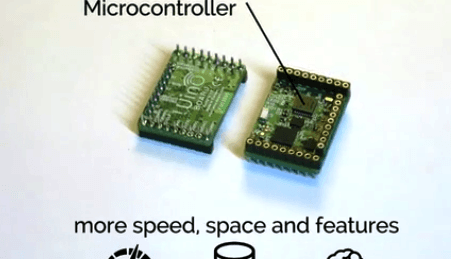Wino… Like Arduino, Only smaller

The Wino board is an Arduino-like stackable development system which is both smaller and cheaper than Arduino units and features built-in WiFi as standard.
The main Wino controller board measures 26.5 x 18.5 mm and is fitted with an Atmel ATSAMD21 running at 48 MHz with 128 kB Flash storage and...
The main Wino controller board measures 26.5 x 18.5 mm and is fitted with an Atmel ATSAMD21 running at 48 MHz with 128 kB Flash storage and...
The Wino board is an Arduino-like stackable development system which is both smaller and cheaper than Arduino units and features built-in WiFi as standard.
The main Wino controller board measures 26.5 x 18.5 mm and fitted with an Atmel ATSAMD21 running at 48 MHz with 128 kB Flash storage and 16 kB RAM. The board uses the ESP8266EX WiFi module which supports all the 802.11 b/g/n standards offering P2P and soft-AP modes and TCP-IP / UDP, static IP and DHCP networking. The 27-pin stackable connections around the board periphery provide connections for 15 digital GPIO pins, 6 x 12-bit ADCs and a 1 x 10-bit DAC.
The controller board is set to retail at 10 Euros and is supported by a number of stacking peripheral boards which offer a USB port for serial comms, programming and power, a button-cell battery board to power the system for mobile applications and a programming board providing a debugger interface, FTDI and Arduino-compatible header connectors to connect shields. Other boards provide relay switching functions, temperature sensor inputs, motion sensing and servo control.
Code development on the system is via the Arduino IDE. The Wino system still has around two weeks left to run of its Kickstarter campaign and is close to halfway along to its funding target.
The main Wino controller board measures 26.5 x 18.5 mm and fitted with an Atmel ATSAMD21 running at 48 MHz with 128 kB Flash storage and 16 kB RAM. The board uses the ESP8266EX WiFi module which supports all the 802.11 b/g/n standards offering P2P and soft-AP modes and TCP-IP / UDP, static IP and DHCP networking. The 27-pin stackable connections around the board periphery provide connections for 15 digital GPIO pins, 6 x 12-bit ADCs and a 1 x 10-bit DAC.
The controller board is set to retail at 10 Euros and is supported by a number of stacking peripheral boards which offer a USB port for serial comms, programming and power, a button-cell battery board to power the system for mobile applications and a programming board providing a debugger interface, FTDI and Arduino-compatible header connectors to connect shields. Other boards provide relay switching functions, temperature sensor inputs, motion sensing and servo control.
Code development on the system is via the Arduino IDE. The Wino system still has around two weeks left to run of its Kickstarter campaign and is close to halfway along to its funding target.
